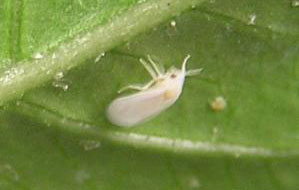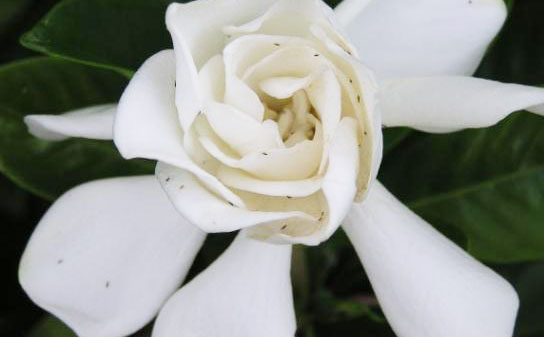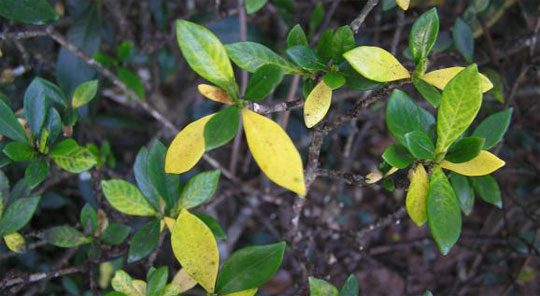Yellow Leaves And Insects Pester Gardenias
May 8, 2010
The gardenia, with its bright white, fragrant blooms and glossy, dark green leaves, is a favorite landscape shrub in Florida.
A brief history
Gardenias originated in China, where it was cultivated for more than 1,000 years. In 1761, British naturalist John Ellis received a specimen of this plant from China and named the plant after his friend Dr. Alexander Garden, a noted botanist and physician in Charleston, South Carolina.
 In the 1920s and 1930s, gardenias became highly prized as a cut flower for corsages and arrangements. Today gardenias are a favorite shrub in the Florida landscape and are acclaimed for their creamy-white blossoms and unique fragrance of vanilla, jasmine, and nutmeg, a fragrance that becomes spicier as the gardenia blooms age.
In the 1920s and 1930s, gardenias became highly prized as a cut flower for corsages and arrangements. Today gardenias are a favorite shrub in the Florida landscape and are acclaimed for their creamy-white blossoms and unique fragrance of vanilla, jasmine, and nutmeg, a fragrance that becomes spicier as the gardenia blooms age.
While gardenia is a lovely landscape shrub, it is not without problems.
Yellow leaves
Yellow leaves are a common complaint among gardenia-growers. Yellowing, or chlorosis, may be due to a number of causes.
One of the first things to consider is an iron deficiency. Gardenias generally require more iron than other plants. In high pH (alkaline) soils, iron is not readily available. Lack of iron will result in yellow leaves.
To correct this problem, first see if your soil pH is the issue by getting a soil test. Sometimes, foliar applications of iron are effective. Follow the directions on the product label. In addition, fertilize your gardenias with an “acidifying” fertilizer.
Other causes of yellow leaves include insufficient light, over watering or poor drainage, soil temperature that is too low, nematode damage or disease.
Even though gardenias are evergreen plants, they do go through a period of leaf replacement. Some yellowing on older leaves is normal and may occur during the spring months before new growth appears.
Whiteflies
As their name implies, whiteflies are small, fly-like insects with white-colored wings. They hide on the underside of leaves, where they multiply rapidly. Whiteflies suck on plant juices and, in large numbers, can consume a considerable amount of nutrients. Like aphids, they excrete lots of honeydew, on which black sooty mold fungus grows.
 The key to whitefly control is not a specific insecticide–the key is persistence. Almost any insecticide will kill a whitefly. Insecticidal soap, neem oil, horticultural oil, permethrin, bifenthrin and lambda-cyhalothrin are deadly to the insect.
The key to whitefly control is not a specific insecticide–the key is persistence. Almost any insecticide will kill a whitefly. Insecticidal soap, neem oil, horticultural oil, permethrin, bifenthrin and lambda-cyhalothrin are deadly to the insect.
Since whiteflies live under gardenia leaves, it is critical to direct your spray upwards under the leaves. Plan to spend several minutes with each gardenia, working to achieve complete coverage. One spray won’t kill all of them. Nearby plants harbor the creatures and they will move back in within a few days.
Thrips
In early summer, the gardenia will reward gardeners with fragrant blooms. However, the blooms are frequently infested with an insect known as thrips.
Thrips are very small insects with piercing-sucking mouthparts. In addition to causing discoloration of petals, they can also cause leaf malformation (distorted, dwarfed, and matted), leaf fold, leaf roll, leaf blisters, and sometimes defoliation.
 To aid in detecting thrips, place a sheet of white paper beneath the leaves or flowers and shake the plant. The thrips will fall onto the paper and can be more easily observed and identified than when on the plant.
To aid in detecting thrips, place a sheet of white paper beneath the leaves or flowers and shake the plant. The thrips will fall onto the paper and can be more easily observed and identified than when on the plant.
Since thrips may come in large flights over an extended period of time, insecticides which give good initial results but have a short residual effect are generally inadequate for control of thrips infestations. Systemic insecticides are highly effective and provide long-term control.
For more information, contact Theresa Friday at 850-623-3868 or email tlfriday@ufl.edu. Friday is the Residential Horticulture Extension Agent for Santa Rosa County.
Courtesy photos by Theresa Friday for NorthEscambia.com, click to enlarge.
Comments
4 Responses to “Yellow Leaves And Insects Pester Gardenias”




Something is eating my gardenia leaves in big bites, but I cannot find any insects on it or the soil during the day or night. Do you have an idea what it may be and how to fight it?. I must add that the gardenia is in a screen porch in a large flower pot. Thank you.
My Gardenias seem very healthy, but many of the leaves are stunted. Do you have any suggestions as to the cause?
You suggest a systemic insecticide for control of thrips. I have never had to deal with this before… What should I use? Great article! Some suggestion on the care & treat would also be helpful
very helpful information! Thank you!